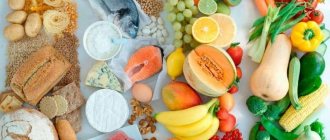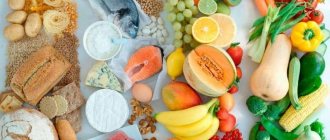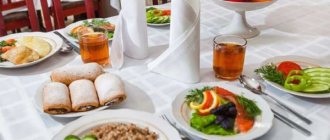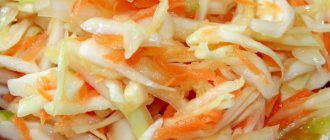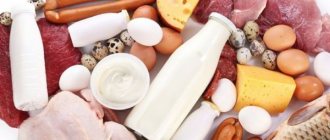Healthy eating is the key to good health and a slim body. If you follow its simple principles, you can lose excess weight, improve your health, and cleanse your body of toxins. To benefit from proper nutrition, it must be maintained throughout your life. First of all, you need to find out which foods should be present in your diet and which should be avoided. This way, you will be able to create a menu and not deviate from the correct diet. Healthy eating: menu for every day.
Basic rules of healthy eating
- Avoid fast food, smoked foods, sweets, flour, and refined white rice.
- Eat as many seasonal fruits and vegetables as possible.
- Replace bread made with wheat flour with one made from whole grain flour.
- Try using honey instead of sugar.
- Maintain drinking regime. You need to drink at least 2-2.5 liters of clean water per day.
- Limit your consumption of strong coffee and sugar.
- Strictly avoid sugary carbonated drinks.
- Try to enrich your diet with foods that are sources of animal and vegetable protein.
- Steam, boil and bake dishes. Eat vegetables raw as often as possible.
- Replace regular salt with sea or Himalayan salt.
- Be careful with alcoholic drinks, because they are quite high in calories and stimulate the appetite.
Molecular basis of a balanced diet
No diet can be called balanced if it does not contain enough carbohydrates, fats, proteins, fiber, vitamins or minerals. Let's briefly remember why the body needs these substances.
Carbohydrates. It is very difficult to achieve a zero carbohydrate content in the diet, but if this happens, then you can be sure that such nutrition will do more harm than good to the body (even with severe obesity). Carbohydrates serve as the main source of energy. In addition, they are necessary to maintain muscle shape (with a deficiency of carbohydrates, building protein from the muscles is consumed), these same substances serve as “food” for beneficial bacteria living in the intestines. Nutritionists advise composing your diet so that it consists of 45% carbohydrates (ideally, these should be slow carbohydrates).
Fats. Our body needs fats of plant and animal origin. They serve as an energy source, are indispensable for the proper functioning of the brain and nervous system, are important for maintaining the health of the skin and other tissues, are a component of cell membranes and an organic basis for the synthesis of steroid hormones. Fatty foods serve as a source of essential fatty acids (from the omega group), and are also indispensable for the proper absorption of fat-soluble vitamins A, , and.
Squirrels. The human body is, in fact, a collection of different proteins (our body contains from 30,000 to 50,000 types of protein compounds). Protein food is a source of essential amino acids, it is necessary for the formation of DNA, enzymes, hormones and special proteins in the body responsible for the transport of oxygen in the blood and the growth of muscle tissue, it is necessary for the normal condition of bones, hair, and nails. Without exaggeration, every cell in the human body needs proteins. The source of this nutrient should be natural food, since the bioactivity of protein food supplements is much worse. Although protein abuse is just as dangerous for humans as protein deficiency.
Cellulose. Another name for this substance is dietary fiber. This is a special type of carbohydrate that is not absorbed by the body. The indispensability of fiber is that it is responsible for the normal functioning of the intestines and maintains healthy microflora in it, improves digestion, removes toxins from the body and reduces the risk of developing cancer. But when taking large amounts of fiber, it is important to ensure that you drink enough fluids, otherwise there is a risk of constipation.
Vitamins. You can talk about the benefits of these substances for a very long time, and about each separately. In short, each of them performs its own function, which is collectively manifested by the correct growth, development and smooth functioning of the entire system of the human body. As a rule, a lack of any of the vitamins triggers a domino effect, and as a result, the entire body suffers.
Minerals. Our bodies cannot produce minerals on their own, so it is important to replenish their reserves from food. Each mineral, like vitamins, plays a specific role in the body. Maintaining mineral balance is the key to the balanced functioning of all organs and systems, including healthy bones, teeth, skin and hair, blood composition and healthy metabolism.
What foods should you avoid on PP?
Proper nutrition means avoiding foods that lead to fat deposition, clogging the body and slowing down metabolism.
You will have to remove from your diet:
- Chips, crackers, salted nuts.
- Semi-finished products in the form of instant noodles, pancakes, dumplings, dumplings.
- Bakery products based on yeast and wheat flour.
- Fried and smoked dishes.
- Store-bought sauces, ketchups, mayonnaise.
- Fast food, sausages, sausages.
- Store-bought juices and sweet carbonated drinks.
How to create a healthy food menu for the week
Selecting a menu should not be particularly difficult; the main thing is to know the basic principles of proper nutrition. It is necessary to make a separate list of products and distribute them by day. Keep in mind that you should never skip breakfast. Moreover, it should be balanced and satisfying. To prepare dinner, you need to give preference to protein foods and fresh vegetables. A healthy diet does not prohibit snacking. Fruits, dried fruits, and nuts are ideal for this. Drink as much clean water as possible, replace black tea with green tea, and don’t forget about fresh juices.
Applications for phones and PCs that generate lists
“Buy a loaf” is a very convenient application that clearly shows all the products that you need to buy, makes it easy to mark the products you have already purchased and add new ones along the way. And the already compiled list can be shared with any user, which significantly saves your time. And all this, of course, is in your pocket.
“Ol Shopping List” is another equally convenient application. Has a manual input feature where you can literally use your finger to write down what you need instead of running your fingers around a small manual keyboard. It also allows you to create several lists with different themes at once, and also allows you to choose a background theme that suits you more, which makes the shopping process more enjoyable.
“Shopping list: for bread!” An equally convenient application in which everything is quickly and easily displayed on a screen stylized as a yellow notebook sheet. Purchases of particular importance can be highlighted using a “marker”, and those already purchased can be deleted with one touch. Another very convenient plus is the ability to voice dial.
“Buy Me” is an application that won the hearts of users very quickly due to its bright interface, which highlights the necessary products with a background created from pictures of this product. Allows you to understand the necessary products without reading, everything is immediately visible from the picture. "Shopping: listick." An incredibly convenient application that performs several functions required by the user at once. You can create a lot of different lists - exactly as many as you need - no one will limit you. A large database of products and household goods will allow you to avoid long input of products - possible options will begin to pop up from the first letter of the name. And then the application independently distributes products into categories, which makes it much easier to navigate the supermarket. And another nice bonus - the application has a function for calculating user expenses.
Every day menu for the whole family with recipes
Monday
- Breakfast: omelet of 2 whites and 1 yolk, a slice of whole grain bread with cheese, fresh juice or green tea.
- Snack : fruit (apple, banana, pear), yogurt.
- Lunch: vegetable soup with a slice of whole grain bread, buckwheat or pearl barley porridge with butter, baked fish with vegetables.
- Second snack: baked apple, low-fat cottage cheese with honey.
- Dinner : chicken fillet with bell peppers and onions, a glass of low-fat kefir.
Tuesday
- Breakfast: oatmeal with dried fruits and grated apple, tea or coffee.
- Snack: salad of fresh tomatoes and cucumbers with herbs, a slice of cheese.
- Lunch: borscht, baked potatoes with butter and natural spices, vegetable salad.
- Second snack : curd mixture with cottage cheese, green tea.
- Dinner : grilled vegetables, steamed fish cutlets.
Wednesday
- Breakfast: buckwheat porridge with milk, a sandwich of unleavened bread with cheese, tea or coffee without sugar.
- Snack : a piece of casserole with apples.
- Lunch : fish soup, a slice of rye bread, stewed veal with vegetables.
- Second snack: fruit salad.
- Dinner : steamed vegetables, chicken cutlet, low-fat homemade yogurt.
Thursday
- Breakfast : omelet of 3 whites, 1 yolk and milk, a slice of rye bread with butter.
- Snack : apple, banana, yogurt.
- Lunch : rice, steamed fish, salad of cucumbers, tomatoes, herbs, radishes and olive oil.
- Second snack : cheesecakes, green tea.
- Dinner : baked potatoes with olive oil, boiled seafood (mussels, shrimp).
Friday
- Breakfast : banana-curd casserole, apple, fresh juice.
- Snack : slice of cheese, coffee, apple.
- Lunch : chicken broth, carrots, steamed broccoli or cauliflower, boiled fish, a slice of rye bread.
- Second snack: thick fruit smoothie with a handful of nuts
- Dinner : Turkey with fresh seasonal vegetable salad.
Saturday
- Breakfast : couscous with honey, nuts and raisins, green tea or coffee.
- Snack : apple, bread with cheese and tomato.
- Lunch: buckwheat with stewed mushrooms, carrots and onions, baked hake.
- Second snack: jelly made from natural juice, cheesecakes.
- Dinner : vinaigrette, boiled fillet.
Sunday
- Breakfast : buckwheat, boiled egg, bread with cheese, coffee.
- Snack : dried fruits, apple, green tea.
- Lunch : lentil soup, bulgur, boiled beef, cabbage and carrot salad.
- Second snack: cheesecakes, banana.
- Dinner : omelet with tomatoes, seafood.
Healthy nutrition menu options
For women
Metabolism in women is not as fast as in men, which is due to lower muscle mass. This means that calorie needs are reduced by 15%. However, a woman’s body has a special need for certain vitamins (A, E, C). Their lack can cause various health problems, in particular, suppression of reproductive function. This is why most diets can negatively affect the female body. PN for women should be based on the consumption of fresh fruits, vegetables, and lean protein foods. Special attention should be paid to sources of omega3 fatty acids.
To dress salads you need to use olive and flaxseed oil. Breakfast should be hearty (porridge, omelette, yogurt). For lunch, it is advisable to eat meat or fish, fresh vegetables. Dinner should be light.
You can read about the healthiest vegetable oil in our article.
For men
Proper nutrition for men is an important factor on which their health and overall well-being depend. For each representative of the stronger sex, PP is also a source of energy. A balanced menu will allow you to stay fit without compromising your health. You can make adjustments to the menu - it all depends on how active the man is. Age plays a significant role. The basis of the diet should be proteins, fats and carbohydrates. For the normal functioning of the body, vitamins and minerals are necessary, so the menu should include vegetables, fruits, cereals, meat, fish, and nuts.
For teenagers
The nutrition of a teenager is not very different from a healthy menu that is intended for adults. At this age, a child needs to eat a balanced diet. The diet should be dominated by foods rich in vitamins and microelements. If a child tends to be overweight, high-calorie foods will have to be eliminated from the menu. Breakfast should be given special attention. It can consist of milk porridge, omelet, cottage cheese with fruit. For lunch, you must definitely eat first courses, side dishes with meat and vegetables. The main emphasis should be on protein foods. It is also important to find an alternative to store-bought sweets. You can replace them with honey, dried fruits, homemade marmalade, and marshmallows. Dark chocolate, natural jams, jellies, and puddings are welcome. Dates, dried apricots, walnuts, raisins, bananas, and apples are ideal as snacks.
Oatmeal
· It is with the help of soluble fiber, which is found in oatmeal grains, that sugar is washed out of the blood, and with the help of insoluble fiber, harmful toxins are removed from the body.
· Oatmeal promotes good digestion, since the necessary elements envelop the walls of the stomach.
· It contains many microelements necessary for the body: calcium, potassium, magnesium, iodine, fluorine and others.
· It is recommended to add oatmeal to the diet if you have diabetes, liver disease, and gout.
· This porridge has a good effect on the skin, strengthens hair and nails.
· It helps improve memory and attention; it is recommended for physical and mental stress.
· It has a good effect on the thyroid gland, since it contains such a necessary trace element as iodine.
· This cereal has a wonderful effect on the body, giving a rejuvenating effect.
Oatmeal is one of several cereals that nutritionists recommend for daily consumption, so one cannot but agree with its beneficial qualities. After all, one cannot underestimate the benefits of cereals for the health of the body.
Millet porridge
· Since this cereal is practically unprocessed, it has a lot of intact valuable fiber.
· It is recommended for heart patients and diabetics to eat this porridge regularly.
· Wheat contains carbohydrates, fiber, minerals, including copper, magnesium, potassium, manganese, and iron.
· This cereal helps remove waste, toxins and heavy metal salts from the body.
· It is a low-calorie product, which is why it has the well-deserved name “slimness porridge.”
· Affects the reduction of cholesterol levels in the blood, cleanses blood vessels.
· Fights even against chronic fatigue and vitamin deficiency.
· Wheat cereal has a lot of vitamin D, and this affects the growth of bones, as well as the beauty of your nails and hair.
It is thanks to the presence of vitamin D that this porridge is very useful for children. Also interesting is the fact that wheat porridge, despite the name, is made from millet.
Menu for weight loss
Monday
- Breakfast : oatmeal on water with raisins and apple, green tea or coffee.
- Snack : a slice of cheese and a handful of nuts.
- Lunch : vegetable soup, steamed chicken fillet, salad of cabbage, carrots, herbs and olive oil.
- Second snack: cottage cheese casserole, fresh juice.
- Dinner : seafood or lightly salted fish, two-egg omelette, kefir.
Tuesday
- Breakfast : buckwheat porridge with a piece of butter, a slice of cheese with rye bread and tomato, tea or coffee. Snack: dried fruits, apple.
- Lunch : bean soup, steamed cutlets, wild rice with olive oil.
- Second snack: casserole, yogurt.
- Dinner: salad of daikon radish, carrots, boiled egg and herbs, shrimp.
Wednesday
- Breakfast : cheesecakes, apple, coffee or tea.
- Snack : whole grain bread sandwich with cheese, dried fruits, green tea.
- Lunch : soup with meatballs made from minced chicken and veal, buckwheat with sauerkraut, baked fish.
- Second snack : yogurt, banana.
- Dinner : baked turkey with a salad of cucumbers, tomatoes, fresh herbs, flaxseed or olive oil.
Thursday
- Breakfast : omelet of 3 eggs (2 whites, 1 yolk), stewed vegetables (broccoli, cauliflower, carrots, onions, green peas), tea.
- Snack : fruit salad, coffee with a sandwich (rye bread with a slice of bread).
- Lunch : salmon fish soup, rice with vegetables, fresh seasonal vegetables.
- Second snack : cottage cheese casserole, dried fruits, green tea.
- Dinner: baked fish, low-fat yogurt.
Friday
- Breakfast : whole grain oatmeal porridge with grated apple and honey, coffee with a slice of cheese.
- Snack : cottage cheese casserole, fresh juice.
- Lunch : borscht, salad of Chinese cabbage, fresh herbs and olive oil, boiled chicken fillet.
- Second snack : baked apple, green tea.
- Dinner : Steamed broccoli, Brussels sprouts or cauliflower, steamed fish cake.
Saturday
- Breakfast: cottage cheese with fruit and honey, coffee or tea.
- Snack : apple, sandwich with cheese and tomato.
- Lunch: bulgur with champignons, seaweed, baked fish.
- Second snack : baked apple, low-fat homemade yogurt.
- Dinner: salad of boiled chicken fillet, eggs, cucumbers and herbs.
Sunday
- Breakfast : buckwheat porridge with stewed vegetables, coffee with a piece of cheese.
- Snack : salad of oranges, apples, kiwi.
- Lunch : mushroom soup, chicken breast with Korean carrots.
- Second snack : cottage cheese casserole with raisins, green tea.
- Dinner : grapefruit, fish with steamed vegetables.
List of budget foods for a healthy diet
Proper nutrition is simple and accessible. To feel good and maintain weight, you can cook simple but healthy meals.
The list of budget products includes:
- Cereals (oatmeal, rice, buckwheat, pearl barley).
- Legumes (beans, peas, lentils).
- Whole grain bread or crispbread.
- Vegetables (beets, carrots, onions, radishes, cabbage).
- Fresh herbs (dill, parsley, lettuce, basil).
- Lean meats (chicken fillet), fish (hake, pollock).
- Eggs.
- Dairy products (cottage cheese, kefir, fermented baked milk, homemade yogurt).
- Seasonal fruits (apples, pears, oranges, grapefruits, kiwis).
- Seasonal berries (strawberries, raspberries, currants, cherries, blackberries).
Recipes: PP for weight loss
We offer several simple recipes for healthy dishes that can be included in the menu.
Cottage cheese casserole
To prepare low-calorie oatmeal you will need:
- cottage cheese with a minimum fat content – 250 g;
- low-fat milk – 0.5 tbsp;
- chicken eggs – 2 pcs.;
- vanilla sugar;
- whole grain flour - 3 tbsp. l.
Cooking method:
- Combine cottage cheese, milk, eggs and vanilla. Beat with a blender.
- Add flour to the curd mixture.
- Preheat the oven to 180 degrees.
- Fill the baking dish with the mixture and place in the oven for half an hour.
Baked fish with lemon
To prepare we will need:
- lean fish (hake, pollock).
- onion – 1 pc.;
- lemon – 1 pc.;
- olive oil – 2 tbsp. l.;
- fresh herbs;
- salt, spices.
Cooking method:
- Clean the fish.
- Divide the lemon into two parts. Squeeze the juice out of one half and chop the other half.
- Chop the greens, mix with oil and lemon juice.
- Preheat the oven to 180 degrees. Place the fish carcass on a baking sheet, place lemon and onion slices on top of it. Drizzle with sauce. Bake for about 30 minutes.
You can learn about the healthiest fish from our article.
Rice with vegetables and mushrooms
For the dish you will need
- rice - 1 tbsp.;
- onion – 1 pc.;
- bell pepper - 1 pc.;
- champignons – 300 g;
- spices and salt to taste.
Cooking method:
- Boil the rice. Chop the onion, pepper and champignons, simmer them in a frying pan with olive oil.
- Combine rice with vegetables, season with spices.
What to pay attention to when planning your diet
First of all, it is necessary to assess the level of physical activity and calculate the daily calorie intake.
Physical activity can be:
- Minimal - when a person leads a sedentary lifestyle and does not play sports.
- Light - if you have to sit mostly at work, and you can train no more than 2-3 times a week.
- Moderate – implying physical activity of low intensity (up to 5 workouts per week).
- High - when everyday work is inseparable from intense training. A complete sports lifestyle.
- Extremely high - very hard work plus daily training.
Having determined the level of load, calculate the calorie intake per day. This is done using the Mifflin-San Geor formula:
Simplified version:
- for men: 10 x weight (kg) + 6.25 x height (cm) – 5 x age (g) + 5;
- for women: 10 x weight (kg) + 6.25 x height (cm) – 5 x age (g) – 161.
Modified version:
- for men: (10 x weight (kg) + 6.25 x height (cm) – 5 x age (g) + 5) x A;
- for women: (10 x weight (kg) + 6.25 x height (cm) – 5 x age (g) – 161) x A.
A is the level of human activity, the degree of which is presented above.
To simplify the calculation, we have made a convenient calculator
Daily menu option for athletes
- Athletes' nutrition should be calculated based on the percentage of proteins, fats and carbohydrates.
- You need to eat at least 5 times a day.
- Products need to be steamed, boiled or baked.
- PP for people who play sports should be based on cereals, lean meats and fish, nuts, vegetables and fruits.
- Products that act as a source of carbohydrates should be consumed in the first half of the day; after lunch, the emphasis should be on protein.
Natalia
Author
Ask a Question
If you have decided to switch to a healthy diet, you should not push yourself into strict limits. It is not at all difficult to adhere to the basic principles of PP; the main thing is to realize that this should become a way of life. Over time, the habit of eating healthy and nutritious foods will become unchanged, and you will notice how much your health and appearance have improved. And your family will probably support you in this useful habit: taking care of your health. Health to you and your loved ones!
Where is the best place to buy? How to go shopping correctly?
Another important factor that not everyone remembers is the “correct” trip to the store. Yes, yes, even with a list, alas, the purchase does not always go smoothly.
This need is due to several factors.
The first is, of course, savings, because the same fruits sometimes cost almost twice as much in the supermarket as in the local market.
The second is the quality of the products, because everyone knows that buying fermented milk products in a dairy store is much safer, because you want to eat not only economically, but also healthy, right?
And finally, the third one is help in following the list. No matter how diligently you make a list, if you go shopping in a bad mood, you run the risk of stuffing that “stupid leaf” into a distant pocket and heading straight to the candy store or the prepared goods department.
The first tip is to always go to the store on a full stomach. Yes, it’s not always convenient and you’ve probably heard these words a thousand times already, but think about it, they’re probably repeated to you every day for a reason. This advice has been tried and tested over the years and tested by dozens of people, so you better just listen to it. Supermarket owners know human psychology very well and will very cleverly extract an extra couple of hundred rubles from you without you even noticing it. So don't follow their lead.
Tip two - before going to the store, prepare yourself for this and do not allow yourself to go in a bad mood or in a hurry, hoping that you can quickly buy everything, bring it home and rush to a meeting or somewhere else. You can't. Going to the store for a week will require a lot of effort and time and you need to be prepared for it. It is unlikely that you will want to run somewhere after this lesson.
But a bad mood affects you like hunger; in fact, they are even very strongly connected most often. When you feel lonely or depressed, you will want to fill the emptiness within yourself with the colorful and colorful offers of smart marketers who promise you the happiness of an extra chocolate bar. Even if happiness comes, it will be fleeting and it will come to you along with an extra couple of kilograms.
Tip three - purchase certain types of products in specialized stores. If you are concerned about the quality of the products you purchase, it is better to buy everything from different places, rather than running to the nearest cheap, and sometimes not so cheap, supermarket to buy everything at once. You can only buy high-quality meat at a good price in a butcher shop, and high-quality fish - accordingly.
It is also better to buy milk in separate shops; they most often have exclusive and high-quality goods without the supermarket markup - there will be more taste and nutrients, and the price will be significantly reduced.
But for groceries - various cereals and pasta, buy them in supermarkets, their prices are almost always low, and the quality does not let you down, and they also offer a wide selection. There you will also find sauces and other little things that may simply not be available in some shops.

